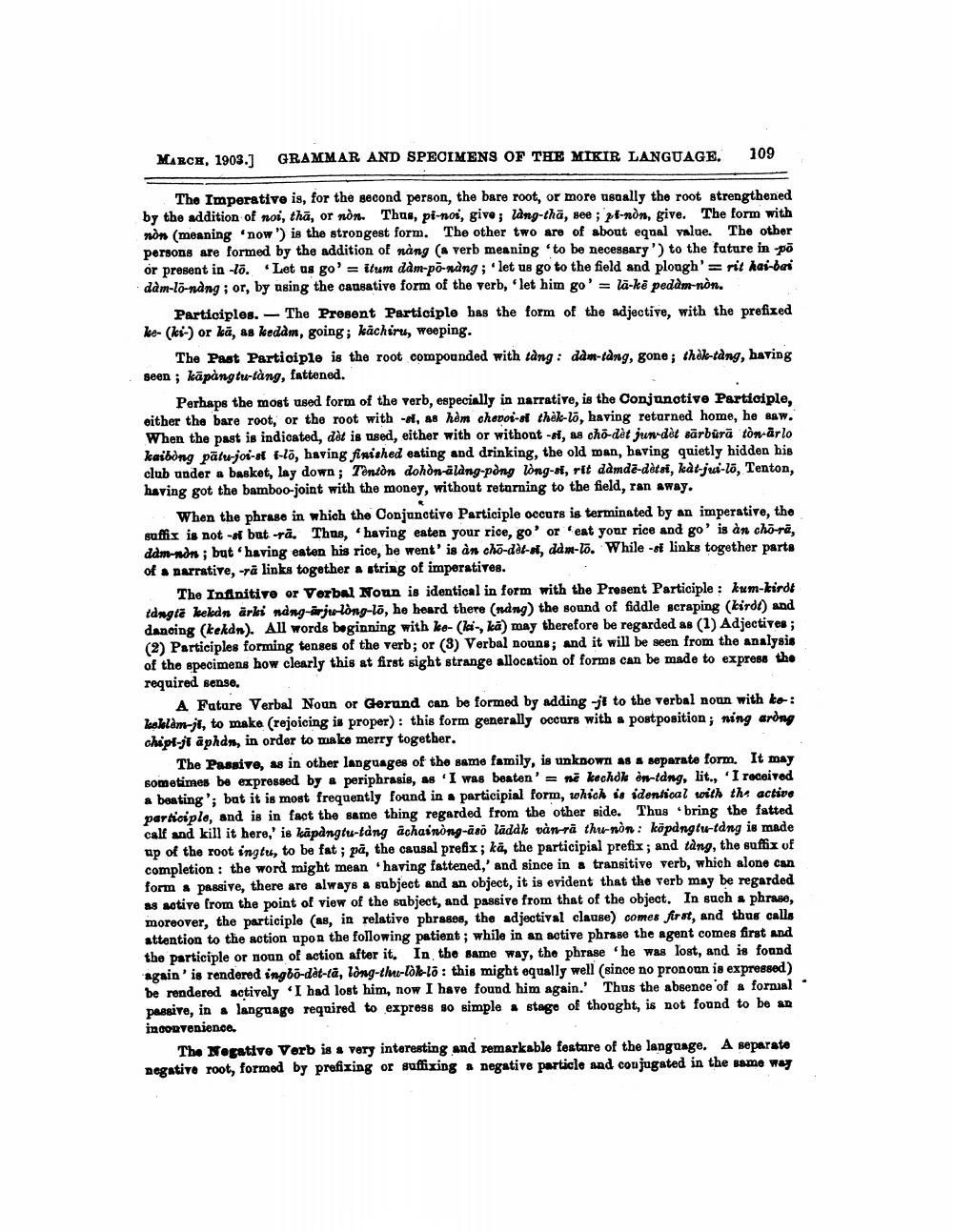________________
MARCH, 1903.)
GRAMMAR AND SPECIMENS OF THE MIKIR LANGUAGE.
109
The Imperative is, for the second person, the bare root, or more usually the root strengthened by the addition of noi, thā, or non. Thus, pi-noi, give; lang-thā, see; pl-non, give. The form with non (meaning now') is the strongest form. The other two are of about eqnal value. The other persons are formed by the addition of nàng ( verb meaning to be necessary') to the future in po or present in -lö. Let us go' = itum dam-po-nang ; let us go to the field and plough'=rit kai-bai dam-lo-nang: or, by using the causative form of the verb, 'let him go' = lä-kë pedam-non.
Participles. - The Present Participle has the form of the adjective, with the prefixed ke- (ki-) or kä, as kedam, going; kâchiru, weeping.
The Past Participle is the root compounded with tàng : dam-tang, gone ; thok-tang, having seen; kāpàngtutàng, fattened.
Perhaps the most used form of the verb, especially in narrative, is the Conjunctive Participle, either the bare root, or the root with -o, as hèm chepoi-sf thek-lo, having returned home, he saw. When the past is indicated, dat is need, either with or withont-rt, as chö-det jun-det särbürā tòn-arlo kaibong pātu-jos-sf f-lo, having finished eating and drinking, the old man, baving quietly hidden his club under a basket, lay down ; Tonton dohòn-alang-pong long-s, rit damda-dest, kåt-ju-lo, Tenton, having got the bamboo-joint with the money, without returning to the field, ran away.
When the phrase in which the Conjunctive Participle occurs is terminated by an imperative, the suffix is not -sf but ra. Thns, having eaten your rice, go' or eat your rice and go' is an chora, dam-non ; but having eaten his rice, be went' is an cho-del-st, da mr-lo. While - si links together parts of a narrative, - å links together a string of imperatives.
. The Infinitive or Verbal Noun is identical in form with the Present Participle : kum-kirdt tongta kekan ärli nang-arju-long-lo, he heard there (ndng) the sound of fiddle scraping (kirdt) and dancing (kekdn). All words beginning with ke-(kai, kā) may therefore be regarded as (1) Adjectives; (2) Participles forming tenses of the verb; or (3) Verbal nouns; and it will be seen from the analysis of the specimens how clearly this at first sight strange allocation of forms can be made to express the required sense.
A Fatore Verbal Noun or Gerund can be formed by adding jl to the verbal noun with to: Roslalam-jt, to make (rejoicing is proper): this form generally occurs with a postposition; ning arong chipl-ji aphan, in order to make merry together.
The Passive, as in other languages of the same family, is unknown as a separate form. It may sometimes be expressed by a periphrasis, as I was beaten' = ne kachok on-tang, lit., 'I received a beating'; bat it is most frequently found in participial form, which is identical with the active parfoi plo, and is in fact the same thing regarded from the other side. Thus bring the fatted calf and kill it here, i8 bãoàngtu-tàng &chaiòng-ado Ladak và Mã thu-ò: köpangtu-tàng is made up of the root ing tu, to be fat; pā, the causal prefix; ka, the participial prefix; and tàng, the suffix of completion : the word might mean having fattened,' and since in a transitive verb, which alone can form a passive, there are always a subject and an object, it is evident that the verb may be regarded as active from the point of view of the subject, and passive from that of the object. In such a phrase, moreover, the participle (as, in relative phrases, the adjectival clause) comes first, and thus calls attention to the action upon the following patient; while in an active phrase the agent comes first and the participle or noun of action after it. In the same way, the phrase "he was lost, and is found again' is rendered ingbo-det-tā, lòng-thu-lok-lo : this might equally well (since no pronoun is expressed) be rendered actively I had lost him, now I have found him again. Thus the absence of a formal passive, in a language required to express so simple stage of thonght, is not found to be ar inconvenience.
The Negative Verb is a very interesting and remarkable feature of the language. A separate negative root, formed by profizing or suffixing a negative particle and conjugated in the same way




